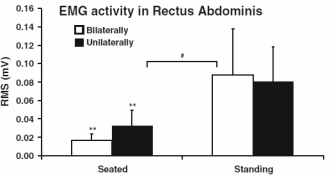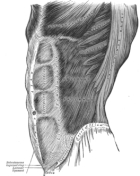|
Train your core and upper body with the same exercises
Strength athletes can train their core muscles while doing dumbbell exercises for the muscles in their arms and shoulders. As long as they do the exercises while standing, and one arm at a time, according to a study published by Norwegian sports scientists at University College in the European Journal of Applied Physiology.
Core muscles
The weakest part of the physique of most strength athletes is their core: the muscles in the hips, lower back and abdomen. These stabilise your body when you move, and our sedentary lifestyle means they are not stimulated enough to develop properly. That's why trainers have been devoting more attention to core muscles since about 2000.
A relatively new finding that trainers are now picking up on is that core muscles can be stimulated more by doing exercises on an unstable surface, like a Swiss ball. Another new discovery is that you train your core muscles better when doing exercises that require you to keep your body stable rather than exercises that require you to move the core muscles. So the plank is a better exercise than crunches.
Study
The Norwegians built on this insight in their study. If strength athletes train the muscles in their upper body while standing, their core muscles have to work harder to stabilise their body than if they perform the exercises while sitting, the researchers reasoned. For the same reason, core muscles have to work harder if athletes train their shoulder and arm muscles one arm at a time - unilaterally rather than bilaterally.

The Norwegians tested their theory in an experiment involving 15 male students. All had been doing strength training for at least five years. The researchers got the students to perform shoulder-presses with dumbbells, in four different ways: seated and two arms together; seated and one arm at a time; standing and two arms together; standing and with one arm at a time.
Results
The researchers attached electrodes to the students' core muscles so that they could measure how hard the muscles were working. They discovered that for the muscles in your lower back it doesn't make much difference how you perform the exercise, but for the rectus abdominis [the six pack muscles] and your oblique abdominal muscles it does make a difference.



The six-pack muscles worked harder when the shoulder press was performed standing; the obliques worked harder when it was performed unilaterally.
Conclusion
"The present study demonstrated greater neuromuscular core activation when exercises were performed standing compared to seated, and unilaterally compared to bilaterally", the researchers write. "We suggest that standing instead of seated exercises, and unilateral instead of bilateral exercises should be considered to increase core muscles activation."
Source:
Eur J Appl Physiol. 2012 May;112(5):1671-8.
More:
Proof: plank is better for your core than crunches 11.08.2012
More proof: crunches alone won't give you a sixpack 23.09.2011
Abdominal training better on a Swiss ball 12.10.2009
Archives:
Strength Training
Core Training
|








